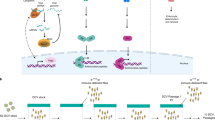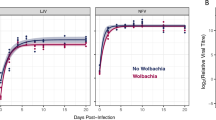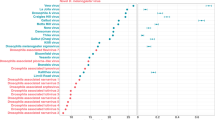Abstract
Host defense to virus infection involves both resistance mechanisms that reduce viral burden and tolerance mechanisms that limit detrimental effects of infection. The fruit fly, Drosophila melanogaster, has emerged as a model for identifying and characterizing the genetic basis of resistance and tolerance. This protocol describes how to analyze host responses to virus infection in Drosophila, and it covers the preparation of virus stocks, experimental inoculation of flies and assessment of host survival and virus production, which are indicative of resistance or tolerance. It also provides guidance on how to account for recently identified confounding factors, including natural genetic variation in the pastrel locus and contamination of fly stocks with persistent viruses and the symbiotic bacterium Wolbachia. Our protocol aims to be accessible to newcomers to the field and, although optimized for virus research using Drosophila, some of the techniques could be adapted to other host organisms and/or other microbial pathogens. Preparation of fly stocks requires ∼1 month, virus stock preparation requires 17–20 d, virus injection and survival assays require 10–15 d and virus titration requires 14 d.
This is a preview of subscription content, access via your institution
Access options
Subscribe to this journal
Receive 12 print issues and online access
$259.00 per year
only $21.58 per issue
Buy this article
- Purchase on Springer Link
- Instant access to full article PDF
Prices may be subject to local taxes which are calculated during checkout





Similar content being viewed by others
References
Medzhitov, R., Schneider, D.S. & Soares, M.P. Disease tolerance as a defense strategy. Science 335, 936–941 (2012).
Ayres, J.S. & Schneider, D.S. Tolerance of infections. Annu. Rev. Immunol. 30, 271–294 (2012).
Lemaitre, B. & Hoffmann, J. The host defense of Drosophila melanogaster. Annu. Rev. Immunol. 25, 697–743 (2007).
Hoffmann, J.A. The immune response of Drosophila. Nature 426, 33–38 (2003).
Bronkhorst, A.W. et al. The DNA virus Invertebrate iridescent virus 6 is a target of the Drosophila RNAi machinery. Proc. Natl. Acad. Sci. USA 109, E3604–E3613 (2012).
van Rij, R.P. et al. The RNA silencing endonuclease Argonaute 2 mediates specific antiviral immunity in Drosophila melanogaster. Genes Dev. 20, 2985–2995 (2006).
Galiana-Arnoux, D., Dostert, C., Schneemann, A., Hoffmann, J.A. & Imler, J.-L. Essential function in vivo for Dicer-2 in host defense against RNA viruses in Drosophila. Nat. Immunol. 7, 590–597 (2006).
Mueller, S. et al. RNAi-mediated immunity provides strong protection against the negative-strand RNA vesicular stomatitis virus in Drosophila. Proc. Natl. Acad. Sci. USA 107, 19390–19395 (2010).
Wang, X.-H. et al. RNA interference directs innate immunity against viruses in adult Drosophila. Science 312, 452–454 (2006).
Kemp, C. et al. Broad RNA interference-mediated antiviral immunity and virus-specific inducible responses in Drosophila. J. Immunol. 190, 650–658 (2013).
Dostert, C. et al. The Jak-STAT signaling pathway is required but not sufficient for the antiviral response of Drosophila. Nat. Immunol. 6, 946–953 (2005).
Merkling, S.H. et al. The epigenetic regulator G9a mediates tolerance to RNA virus infection in Drosophila. PLoS Pathog. 11, e1004692 (2015).
Ferreira, Á.G. et al. The Toll-Dorsal pathway is required for resistance to viral oral infection in Drosophila. PLoS Pathog. 10, e1004507 (2014).
Merkling, S.H. & van Rij, R.P. Beyond RNAi: antiviral defense strategies in Drosophila and mosquito. J. Insect Physiol. 59, 159–170 (2013).
Deddouche, S. et al. The DExD/H-box helicase Dicer-2 mediates the induction of antiviral activity in Drosophila. Nat. Immunol. 9, 1425–1432 (2008).
Teixeira, L., Ferreira, A. & Ashburner, M. The bacterial symbiont Wolbachia induces resistance to RNA viral infections in Drosophila melanogaster. PLoS Biol. 6, e2 (2008).
Cherry, S. & Perrimon, N. Entry is a rate-limiting step for viral infection in a Drosophila melanogaster model of pathogenesis. Nat. Immunol. 5, 81–87 (2004).
Huszar, T. & Imler, J.L. Drosophila viruses and the study of antiviral host-defense. Adv. Virus Res. 72, 227–265 (2008).
Chtarbanova, S. et al. Drosophila C virus systemic infection leads to intestinal obstruction. J. Virol. 88, 14057–14069 (2014).
Eleftherianos, I. et al. ATP-sensitive potassium channel (KATP)-dependent regulation of cardiotropic viral infections. Proc. Natl. Acad. Sci. USA 108, 12024–12029 (2011).
Habayeb, M.S. et al. The Drosophila Nora virus is an enteric virus, transmitted via feces. J. Invertebr. Pathol. 101, 29–33 (2009).
Brun, P. & Plus, N. in The Genetics and Biology of Drosophila, Vol. 2e. (eds. Ashburner, M. & Wright, T.) 625–702 (Academic Press, 1980).
Kapun, M., Nolte, V., Flatt, T. & Schlo, C. Host range and specificity of the Drosophila C virus. PLoS ONE 5, e12421 (2010).
Plus, N., Croizier, G., Jousset, F.X. & David, J. Picornaviruses of laboratory and wild Drosophila melanogaster: geographical distribution and serotypic composition. Ann. Microbiol. (Paris) 126, 107–117 (1975).
Habayeb, M.S., Ekengren, S.K. & Hultmark, D. Nora virus, a persistent virus in Drosophila, defines a new picorna-like virus family. J. Gen. Virol. 87, 3045–3051 (2006).
Chrostek, E. et al. Wolbachia variants induce differential protection to viruses in Drosophila melanogaster: a phenotypic and phylogenomic analysis. PLoS Genet. 9, e1003896 (2013).
Magwire, M.M. et al. Genome-wide association studies reveal a simple genetic basis of resistance to naturally coevolving viruses in Drosophila melanogaster. PLoS Genet. 8, e1003057 (2012).
Dru, P. et al. Unusual variability of the Drosophila melanogaster ref(2)P protein which controls the multiplication of sigma rhabdovirus. Genetics 133, 943–954 (1993).
Contamine, D., Petitjean, A.M. & Ashburner, M. Genetic resistance to viral infection: the molecular cloning of a Drosophila gene that restricts infection by the rhabdovirus sigma. Genetics 123, 525–533 (1989).
van Mierlo, J.T. et al. Convergent evolution of argonaute-2 slicer antagonism in two distinct insect RNA viruses. PLoS Pathog. 8, e1002872 (2012).
Ashburner, M. Drosophila: a Laboratory Manual (Cold Spring Harbor Laboratory, 1989).
Martins, N.E. et al. Host adaptation to viruses relies on few genes with different cross-resistance properties. Proc. Natl. Acad. Sci. USA 111, 5938–5943 (2014).
Costa, A., Jan, E., Sarnow, P. & Schneider, D. The Imd pathway is involved in antiviral immune responses in Drosophila. PLoS ONE 4, e7436–e7436 (2009).
Goic, B. et al. RNA-mediated interference and reverse transcription control the persistence of RNA viruses in the insect model Drosophila. Nat. Immunol. 14, 396–403 (2013).
Durdevic, Z. et al. Efficient RNA virus control in Drosophila requires the RNA methyltransferase Dnmt2. EMBO Rep. 14, 269–275 (2013).
Xu, J. et al. ERK signaling couples nutrient status to antiviral defense in the insect gut. Proc. Natl. Acad. Sci. USA 110, 15025–15030 (2013).
Apidianakis, Y. & Rahme, L.G. Drosophila melanogaster as a model host for studying Pseudomonas aeruginosa infection. Nat. Protoc. 4, 1285–1294 (2009).
Bewick, V., Cheek, L. & Ball, J. Statistics review 12: survival analysis. Crit. Care 8, 389–394 (2004).
Jousset, F.X. & Plus, N. [Study of the vertical transmission and horizontal transmission of 'Drosophila melanogaster' and 'Drosophila immigrans' picornavirus (author's transl)]. Ann. Microbiol. (Paris) 126, 231–249 (1975).
Carpenter, J.A., Obbard, D.J., Maside, X. & Jiggins, F.M. The recent spread of a vertically transmitted virus through populations of Drosophila melanogaster. Mol. Ecol. 16, 3947–3954 (2007).
Habayeb, M.S., Ekström, J.-O. & Hultmark, D. Nora virus persistent infections are not affected by the RNAi machinery. PLoS ONE 4, e5731 (2009).
Ambrose, R.L. et al. Drosophila A virus is an unusual RNA virus with a T=3 icosahedral core and permuted RNA-dependent RNA polymerase. J. Gen. Virol. 90, 2191–2200 (2009).
Vodovar, N., Goic, B., Blanc, H. & Saleh, M.C. In silico reconstruction of viral genomes from small RNAs improves virus-derived small interfering RNA profiling. J. Virol. 85, 11016–11021 (2011).
Wu, Q. et al. Virus discovery by deep sequencing and assembly of virus-derived small silencing RNAs. Proc. Natl. Acad. Sci. USA 107, 1606–1611 (2010).
Flynt, A., Liu, N., Martin, R. & Lai, E.C. Dicing of viral replication intermediates during silencing of latent Drosophila viruses. Proc. Natl. Acad. Sci. USA 106, 5270–5275 (2009).
Kangro, H.O. & Mahy, B.W.J. Virology Methods Manual (Elsevier Science, 1996).
Chambers, M.C., Jacobson, E., Khalil, S. & Lazzaro, B.P. Thorax injury lowers resistance to infection in Drosophila melanogaster. Infect. Immun. 82, 4380–4389 (2014).
Apidianakis, Y. et al. Involvement of skeletal muscle gene regulatory network in susceptibility to wound infection following trauma. PLoS ONE 2, e1356 (2007).
Lemaitre, B., Reichhart, J.M. & Hoffmann, J.A. Drosophila host defense: differential induction of antimicrobial peptide genes after infection by various classes of microorganisms. Proc. Natl. Acad. Sci. USA 94, 14614–14619 (1997).
Teixeira, L.s., Ferreira, A. & Ashburner, M. The bacterial symbiont Wolbachia induces resistance to RNA viral infections in Drosophila melanogaster. PLoS Biol. 6, e2–e2 (2008).
Perrault, J. Origin and replication of defective interfering particles. Curr. Top. Microbiol. Immunol. 93, 151–207 (1981).
McClure, M.A., Holland, J.J. & Perrault, J. Generation of defective interfering particles in picornaviruses. Virology 100, 408–418 (1980).
Lindenbach, B.D. Measuring HCV infectivity produced in cell culture and in vivo. Methods Mol. Biol. 510, 329–336 (2009).
Ayres, J.S. & Schneider, D.S. The role of anorexia in resistance and tolerance to infections in Drosophila. PLoS Biol. 7, e1000150 (2009).
Clark, R.I. et al. MEF2 is an in vivo immune-metabolic switch. Cell 155, 435–447 (2013).
Buchon, N., Silverman, N. & Cherry, S. Immunity in Drosophila melanogaster-from microbial recognition to whole-organism physiology. Nat. Rev. Immunol. 14, 796–810 (2014).
Schneider, D.S. & Ayres, J.S. Two ways to survive infection: what resistance and tolerance can teach us about treating infectious diseases. Nat. Rev. Immunol. 8, 889–895 (2008).
Echalier, G. in Drosophila Cells in Culture (ed. Echalier, G.) 555–595 (Academic Press, 1997).
Acknowledgements
We thank members of the van Rij laboratory for helpful discussions, and P. Miesen for critical reading of the manuscript. For providing fly stocks, we thank the Bloomington Stock Center. This work is supported by a PhD fellowship from the Radboud Institute for Molecular Life Sciences. Research in the laboratory is funded by an Excellent Chemisch Onderzoek (ECHO) project grant (grant number 711.013.001) and the Open Program of the Division for Earth and Life Sciences (grant number 821.02.028) from the Netherlands organization for scientific research (NWO) and a European Research Council consolidator grant under the European Union's Seventh Framework Programme (ERC grant number 615680).
Author information
Authors and Affiliations
Contributions
S.H.M. performed the experiments; S.H.M. and R.P.v.R. conceived and designed the experiments, analyzed the data and wrote the manuscript.
Corresponding author
Ethics declarations
Competing interests
The authors declare no competing financial interests.
Supplementary information
Supplementary Text and Figures
Supplementary Data (PDF 147 kb)
Rights and permissions
About this article
Cite this article
Merkling, S., van Rij, R. Analysis of resistance and tolerance to virus infection in Drosophila. Nat Protoc 10, 1084–1097 (2015). https://doi.org/10.1038/nprot.2015.071
Published:
Issue Date:
DOI: https://doi.org/10.1038/nprot.2015.071
This article is cited by
-
Innate immune pathways act synergistically to constrain RNA virus evolution in Drosophila melanogaster
Nature Ecology & Evolution (2022)
-
Exploiting pyocyanin to treat mitochondrial disease due to respiratory complex III dysfunction
Nature Communications (2021)
-
Peroxisome-associated Sgroppino links fat metabolism with survival after RNA virus infection in Drosophila
Scientific Reports (2019)
-
Immune priming and clearance of orally acquired RNA viruses in Drosophila
Nature Microbiology (2018)
-
The heat shock response restricts virus infection in Drosophila
Scientific Reports (2015)
Comments
By submitting a comment you agree to abide by our Terms and Community Guidelines. If you find something abusive or that does not comply with our terms or guidelines please flag it as inappropriate.



